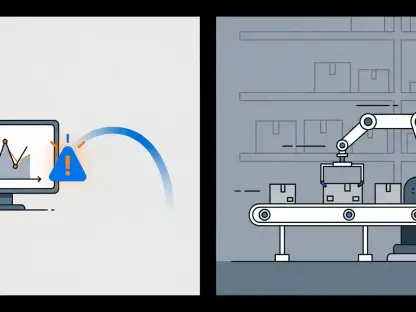In the dynamic realm of financial technology, often abbreviated as fintech, the spotlight typically shines on innovative mobile applications and instantaneous payment solutions that captivate users worldwide. Yet, beneath this glossy exterior, a profound and less visible transformation is taking place in the back-office operations of financial institutions. These essential, behind-the-scenes processes—such as data reconciliation, regulatory reporting, and loan processing—form the operational backbone that keeps the industry running smoothly. Historically burdened by manual, time-consuming tasks, these functions are now undergoing a dramatic overhaul thanks to the advent of automation and Artificial Intelligence (AI). This quiet revolution is not merely a passing trend but a critical evolution, enabling banks and fintech startups across regions like the US and UK to achieve unprecedented efficiency. By embracing these cutting-edge technologies, companies are slashing costs, minimizing errors, and securing a competitive edge in a rapidly evolving market.
Unseen Struggles in Back-Office Workflows
The back-office operations of financial institutions have long been a silent Achilles’ heel, grappling with inefficiencies that hinder growth and profitability. Tasks like manual data entry, transaction reconciliation, and the preparation of regulatory documentation demand significant human effort, often leading to delays and high operational expenses. These repetitive activities not only strain resources but also pose a substantial risk of human error, which can result in costly compliance violations or financial discrepancies. The inability to scale these processes efficiently means that as transaction volumes grow, institutions often struggle to keep pace without exponentially increasing staff numbers. This outdated approach creates a bottleneck, slowing down critical functions and impacting overall performance in an industry where speed and accuracy are paramount.
Beyond the surface-level challenges, deeper systemic issues exacerbate the inefficiencies in back-office workflows. Data silos, where information is fragmented across disconnected systems, prevent a cohesive view of operations, making decision-making and reporting far more cumbersome than necessary. Such fragmentation often leads to duplicated efforts and missed insights, further driving up costs. Additionally, the toll on employees cannot be ignored—endless hours spent on monotonous tasks contribute to burnout, reducing morale and productivity. The reputational risks tied to errors in these processes can also be severe, as a single misstep in regulatory reporting might attract penalties or damage trust with stakeholders. Addressing these entrenched problems has become a pressing need for financial entities aiming to stay competitive.
Harnessing AI for Operational Overhaul
Artificial Intelligence and intelligent automation stand as transformative forces poised to redefine fintech back-office operations. Technologies such as machine learning, natural language processing, and robotic process automation (RPA) are being deployed to tackle repetitive, rule-based tasks with exceptional precision and speed. For instance, AI can analyze and match complex data patterns during reconciliation processes, a task that once consumed hours of manual labor. Similarly, loan processing benefits immensely as automation verifies documents and assesses credit risks in a fraction of the time. These tools are not just about replacing human effort but enhancing it, allowing systems to learn and adapt to increasingly complex operational demands with minimal oversight.
The scope of AI’s impact extends far beyond individual tasks, reshaping entire operational frameworks within financial institutions. Compliance, a critical and often cumbersome area, sees significant improvement as RPA bots automate the generation of regulatory reports, ensuring they are both accurate and submitted on time. Natural language processing further aids by scanning and updating compliance protocols based on evolving regulations. This technological integration allows for scalability, enabling institutions to handle surges in transaction volumes without the need for proportional staff increases. By reducing the dependency on manual intervention, AI not only boosts efficiency but also builds a foundation for innovation, freeing up resources to focus on strategic initiatives that drive long-term growth.
Tangible Gains from Automated Systems
The adoption of automation in back-office operations yields a host of tangible benefits that are reshaping the fintech landscape. Operational efficiency emerges as a primary advantage, with machines taking over repetitive tasks like data entry and invoice processing, thereby cutting down on labor costs significantly. This shift allows financial institutions to redirect human resources toward more analytical and strategic roles, optimizing workforce potential. Moreover, the precision of AI-driven systems minimizes errors in critical areas such as transaction reconciliation, reducing the likelihood of financial losses or compliance issues that could arise from manual mistakes. The cost savings and improved accuracy together create a compelling case for widespread adoption across the sector.
Another profound benefit lies in the indirect impact on customer experience and employee satisfaction. Faster processing times, particularly in functions like loan approvals, mean that clients receive quicker responses, enhancing their overall interaction with financial services. Simultaneously, automation liberates staff from the drudgery of mundane tasks, allowing them to engage in more fulfilling, creative work that adds value to the organization. This shift can lead to higher job satisfaction and better retention rates, addressing a hidden cost of traditional operations. Scalability also plays a crucial role—automated systems can effortlessly manage growing workloads, ensuring that institutions remain agile and responsive to market demands without facing operational bottlenecks. These multifaceted advantages underscore why automation is becoming indispensable.
Hurdles on the Path to Automation
While the promise of automation in fintech back-office operations is undeniable, several challenges complicate its adoption. Data quality stands out as a critical concern, as AI systems depend heavily on accurate and consistent information to function effectively. Inaccurate or incomplete data can lead to flawed outcomes, undermining the very benefits automation seeks to deliver. Additionally, many financial institutions still rely on legacy systems that are not easily compatible with modern AI tools, creating integration hurdles that require significant technical expertise and investment to overcome. These technical barriers often slow down the implementation process, delaying the realization of efficiency gains.
Regulatory and human capital challenges further complicate the transition to automated back-office systems. Ensuring compliance with stringent financial regulations demands that AI applications, especially in sensitive areas like loan underwriting, remain transparent and free from bias—a complex task that requires ongoing oversight. Simultaneously, a notable shortage of skilled talent, including data scientists and engineers with expertise in financial processes, poses a bottleneck for many organizations. Developing or recruiting such specialized personnel is both time-consuming and costly. Addressing these obstacles necessitates a strategic approach, including investments in data infrastructure, system modernization, and training programs to build the necessary expertise. Only through such deliberate efforts can the full potential of automation be unlocked.
Envisioning a Streamlined Financial Future
The trajectory of fintech suggests that back-office automation will become a defining pillar of operational strategy in the coming years. Financial leaders who focus on transforming these unseen processes, rather than solely prioritizing customer-facing innovations, are likely to secure a durable competitive advantage. A phased implementation strategy appears most effective—starting with pinpointing the most inefficient workflows, followed by targeted investments in robust AI and automation technologies. Fostering a collaborative environment where human expertise and machine efficiency complement each other will also be vital, ensuring that technology enhances rather than replaces the human element in financial operations.
Looking ahead, the broader implications of this shift are profound, as automation redefines what operational excellence means in the financial sector. The emphasis on back-office transformation signals a departure from the traditional focus on front-end appeal, highlighting that true value creation often lies in the less glamorous but foundational aspects of business. As institutions worldwide continue to navigate this evolving landscape, the ability to streamline internal processes will likely determine their capacity to innovate and grow. By committing to this quiet revolution, the fintech industry stands poised to not only enhance efficiency but also build resilience against future challenges, setting a new standard for performance and adaptability.









